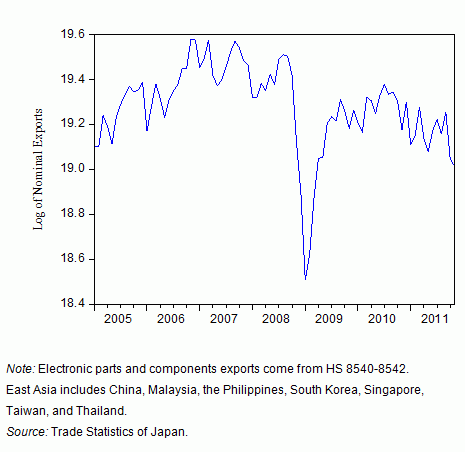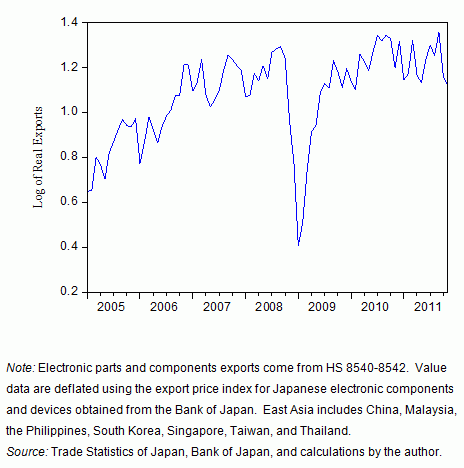| Author Name | THORBECKE, Willem (Senior Fellow, RIETI) |
|---|---|
| Research Project | East Asian Production Networks and Global Imbalances |
| Download / Links |
This Non Technical Summary does not constitute part of the above-captioned Discussion Paper but has been prepared for the purpose of providing a bold outline of the paper, based on findings from the analysis for the paper and focusing primarily on their implications for policy. For details of the analysis, read the captioned Discussion Paper. Views expressed in this Non Technical Summary are solely those of the individual author(s), and do not necessarily represent the views of the Research Institute of Economy, Trade and Industry (RIETI).
International Macroeconomics Program (FY2011-FY2015)
East Asian Production Network and Global Imbalances Project
Before the Global Financial Crisis, almost 20% of Japan's exports were electronics goods. Much of this occurred within East Asian production networks. Figure 1 shows the value of Japanese electronics parts and components exports to the region. The figure shows that the value of exports fell logarithmically by 100% between the collapse of Lehman Brothers in September 2008 and the trough in January 2009. It also shows that the value of exports averaged about 25% below its pre-crisis level, even three and a half years after the Lehman Shock. Figure 2 presents the volume of electronic parts and components exports to East Asia. The figure shows that the volume of exports fell logarithmically by 88% between August 2008 and January 2009. It also shows that the volume of exports recovered quickly and by 2010 had surpassed its pre-crisis level. The value of exports has not recovered to its pre-crisis level while the volume of exports exceeds its pre-crisis level because yen export prices have fallen. After the yen began appreciating in June 2007, yen export prices for electronic components and devices (ECD) and information communication and equipment (ICE) fell by 30% and 20% more than yen costs, respectively, suggesting that the strong yen reduced the profitability of the Japanese electronics industry.
This paper presents evidence that the appreciation of the yen between June 2007 and the end of 2011 caused the yen price of ECD exports and ICE exports to fall by 25% and more than 20%, respectively, indicating that the strong yen severely squeezed profit margins in the electronics industry. Evidence in the paper also shows that the appreciation of the yen caused a much larger decline in export prices for commoditized goods such as silicon wafers than for differentiated products such as electronic computers. Finally, the paper presents evidence that a 10% appreciation of the yen would reduce the quantity of final electronics goods exports by 10%.
Figure 1
The value of Japanese electronic parts and components exports to East Asia

Figure 2
The volume of Japanese electronic parts and components exports to East Asia


